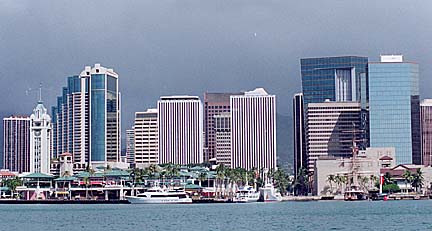


Building the From his office windows on Pacific Tower's 20th floor, Scott McCormack sees daily reminders of his family's legacy.
family business
The real estate boom gave
developers a wild rideDEVELOPING TIES
Rick Daysog / rdaysog@starbulletin.com
The managing director of CB Richard Ellis Hawaii Inc. has a clear view of Nauru and Hawaiki towers, the luxury condominium high-rises his father, Mike McCormack, helped market during the late 1980s and 1990s.
On the Ewa side of his floor, Scott can see the Harbor Court office and condominium complex he helped his father develop at the tail end of Hawaii's last building boom.
To say the McCormack family helped shape Hawaii's real estate industry might be an understatement.
Spanning three generations and more than five decades, the McCormack clan developed hundreds of single-family homes, built hundreds of millions of dollars in office space and luxury condominiums and brokered the sale of thousands of isle residences.

"They were sort of pioneers," said Nick Ordway, University of Hawaii business professor. "They engaged in a number of innovative ideas. A lot of people learned about real estate from the McCormack operation."The family's beginnings in the local real estate market date back to the late 1940s when Thomas McCormack, who died in 1986, developed residences at Ka Hanahou Circle in Kaneohe.
Thomas, Mike's father and Scott's grandfather, was later granted the master leases by the Bishop Estate to develop about 75,000 acres in Kaneohe. The early developments coincided with the growing demand for housing in Hawaii right after World War II.
"My grandfather was well known for his kamaaina integrity, where his word was his bond and his handshake was his signature," said Scott. "He was one of those old-time guys who did what he said he would do."
Mike joined his father's home-building business after graduating from college in 1960. But the younger McCormack, who was more aggressive than his risk-adverse father, struck out on his own to develop residences in Kaneohe.
Alii Shores, Alii Bluffs, Alii Cluster Park and Haiku Plantations were among the projects Mike developed along with various partners.
The 1970s also saw the launch of Mike McCormack Realty, which at one time had offices on every island and employed hundreds of workers. Mike, whose realty firm later became the local affiliate for Coldwell Banker, also began building resort condos on the Kaanapali coast, taking advantage of Maui's economic boom.
"The development on Maui between 1975 and 1980 was absolutely sinful," he said.
The Japanese investment bubble of the 1980s and early 1990s created intense activity for McCormack Properties Ltd. During the late 1980s, McCormack Properties served as the exclusive broker for the Nauru Tower, a 304-unit high-rise overlooking Ala Moana Park.
In partnership with local developer Dick Bradley, McCormack Properties built the $180 million Harbor Court office and residential complex downtown. The project was completed in 1994 just as Hawaii's economy was well into a seven-year tailspin, recalled Scott, who worked with his father to revitalize the project.
After a lengthy legal dispute with the project's Japanese lender, Harbor Court was sold to a group headed by Trinity Investments Trust LLC in 1994, but the McCormack group retained a residual interest.
Scott looks back at the early 1990s as one of the most trying periods for the local real estate business. Many of the creative builders of that era -- including Christopher Hemmeter, Jack Myers and Bruce Stark -- have either left the isles or left the business.
Mike, now 67, also left the isles for greener pastures, first in northern Idaho and now in southern California. He is now developing upscale residential lots outside of Santa Barbara in the town of Montecito and is scouting future developments in Southern California and Mexico.
Scott has adapted to the new realities.
As managing director at CB Richard Ellis, the younger McCormack is in charge of one of the state's largest commercial brokerage firms, which does the leasing and real estate consulting for many of Hawaii's largest corporations.
While he would not rule out a return to the development business, Scott says the demand is not there yet.
Downtown office vacancy rates are down significantly to about 11 percent today from their high of 20 percent in 1996, but office rents are only half of what building owners were charging during the boom years.
Given the topsy-turvy nature of Hawaii real estate, would he encourage any of his young children to get into the business?
"I think being in real estate is all part of our family history," he said.